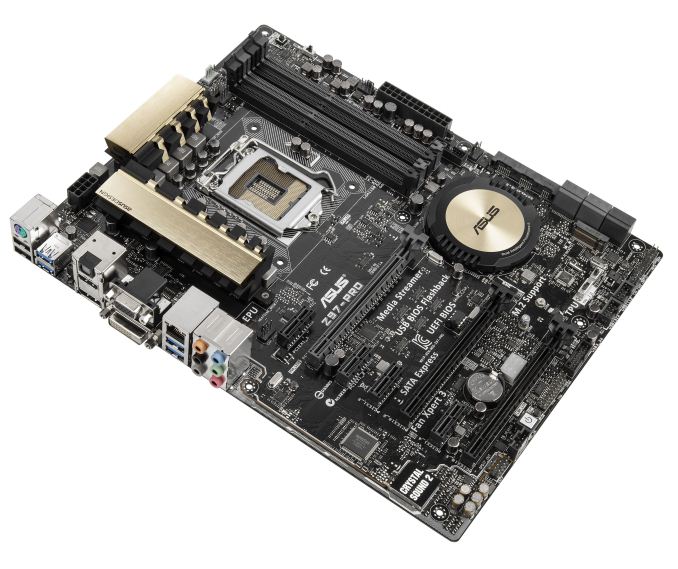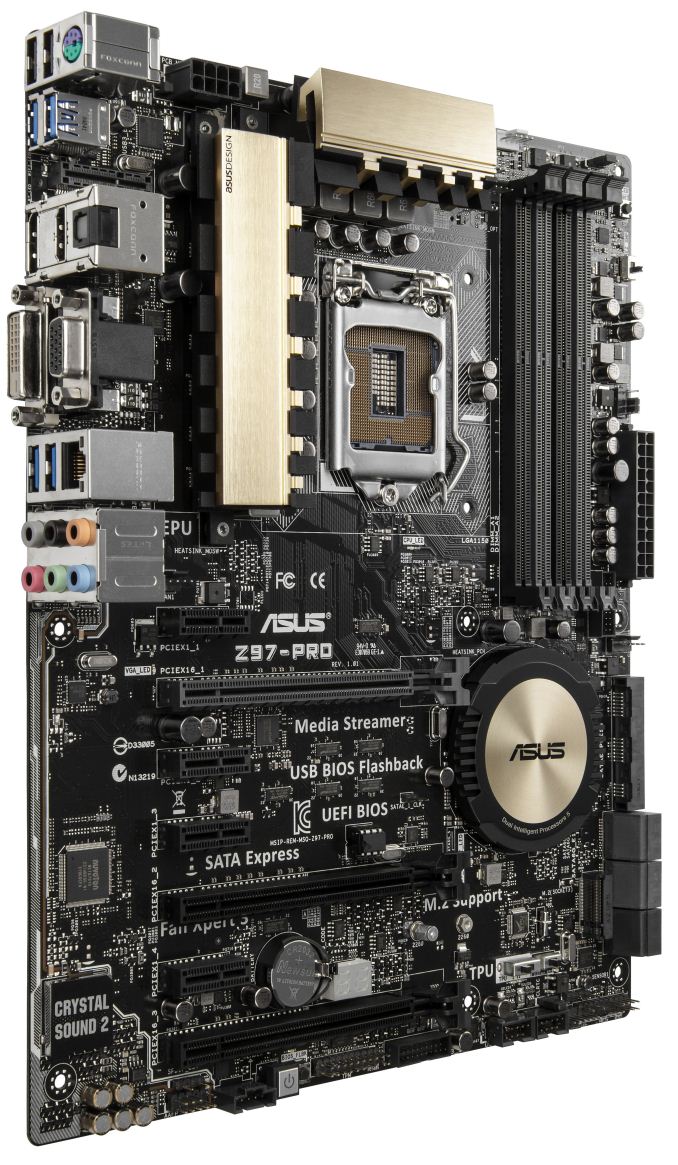ASUS Z97-Pro WiFi AC Review
by Ian Cutress on July 16, 2014 10:00 AM EST- Posted in
- Motherboards
- Asus
- Haswell
- 802.11ac
- Z97
ASUS Z97-Pro WiFi AC Conclusion
The to-and-fro with regards to the new SATA Express and M.2 storage options is not going to go away any time soon. PCIe storage is here to stay, but in the interim motherboard manufacturers have a tough choice to make between M.2 support, SATAe support, or both with some fancy PCIe lane management. ASUS at that point is going to have to be committed to SATAe due to their involvement with ASMedia, and ASMedia is the only company with a SATAe controller in the consumer market. It would seem that this controller is destined for $250+ motherboards, given that the Z97-Pro only has one SATAe from the chipset. It also depends on Intel’s support of SATAe, and whether it will expand in future chipsets to more than one x2 topology.
With that aside, the Z97-Pro has been a solid part of our CPU test bed. In terms of swapping out CPUs, GPUs and memory, I have not come across a problem. The key point in the performance metrics actually comes from the audio, where our motherboard achieved 105.1 dB dynamic range and -84.8 dB THD+N, and the DPC Latency came in under 100 microseconds.
The big challenges from ASUS’ perspective should be the Z97X-SOC, Fatality Z97 and Z97 Gaming 7 which are all in that $188-$210 bracket. ASUS 9-series BIOS shows that growth in these areas are still happening and similar to our Z97-Deluxe review conclusion, having the automatic overclocking option to determine maximum temperature and length of stress testing is something I imagine all other motherboard manufacturers taking on board relatively soon. It should be easy enough to implement as well. While I might not be the BIOS’ biggest fan, the EZ mode and My Favorites menus are evolving, and the fan controls in the BIOS are now second to none. My only additions to those fan controls would be an option to set all fans to ‘high speed’ or ‘silent’ with one click, as is possible in software, and also a measure of hysteresis.
The addition of 802.11ac 2T2R WiFi might have come across as a bit pricy, originally being a $30 addition but has now moved down to +$12. The module cannot be purchased individually and one might argue that a PCIe card to do something similar would cost more, making the WiFi module a good investment. Given that ASUS now ship 3T3R 802.11ac routers, including the dual 3T3R AC3200 model announced at Computex, I wonder how close we are to seeing 3T3R solutions on motherboards. My expectation lies at the feet of X99, however the additional cost is a bit more difficult to predict. Nonetheless, the WiFi option of the Z97-Pro is preferred as a ‘just-in-case’ option should a user’s circumstances change. The XMP switch is also a nice touch that other manufacturers might implement, helping enthusiasts get the full speed out of their memory without worrying about accessing the BIOS.
Even at $200 the system punches above its weight, and the lack of issues across my testing with almost a dozen CPUs for other reviews can only ever be a positive. Users investing into the Z97 ecosystem should consider the Z97-Pro or the Z97-Pro WiFi AC as worthwhile motherboards in their builds.













38 Comments
View All Comments
Samus - Wednesday, July 16, 2014 - link
I'm running a system based on the Asus Z97I-Plus (ITX) with a i5-4690K @ 4.5GHz 1.3v its been rock solid for the month I've had it.Coming from an Asus H81I ITX i5-4670K @ 4.2GHz. There are some mild BIOS improvements but the addition of M2 on the Z97I was what got me. That, and my H81 wouldn't run the Haswell refresh (chipset was old version) so I was pretty much locked into Haswell with no Broadwell/Skylake options for the future.
mapesdhs - Saturday, July 19, 2014 - link
Sounds good! I'm curious though, how are you cooling your 4690K? I've been pondering
whether a K CPU with a moderate oc is viable given I want minimum noise (for the HTPC
build that is).
Ian.
p1esk - Wednesday, July 16, 2014 - link
How could 2x580 be possibly quicker than Titan Black? It's 2x512 cores vs 2,880 cores at higher clock, and Titan has twice memory bandwidth.ZeDestructor - Thursday, July 17, 2014 - link
The cores perform differently. Similar to how clock for clock Haswell is faster than IVB. In this case, the 580 has more powerful, but slower and hotter cores than the titan black.By the looks of it, the blender code isn't memory bound either, which explains why it makes do with the lower bandwidth.
mapesdhs - Saturday, July 19, 2014 - link
As ZeDestructor says, the shader structure is very different in the 500 series, but to
clarify: after the 500 series, NVIDIA halved the shader clock speeds in order to make
power delivery & heat easier to deal with, but this means a lot more shaders are
required to give the same performance (almost 3X as many), eg. I've tested a K5000
which has 3X more shaders, but it's slower than a 580 for CUDA. This is why, for CUDA
tasks, a 580 beats all of the 600 series and most of the 700 series. Also, the 580 has a
lot of bandwidth, so the available bandwidth per core is very high compared to later
designs; this can make a difference in some cases.
See the following (for the Arion test, my system is no. 18 in the table; also note the table
has a typo, system 15 is a triple-780):
http://www.randomcontrol.com/arionbench
http://www.tomshardware.co.uk/forum/id-2173987/gig...
http://forums.creativecow.net/thread/2/1019120
A Titan Black does the Blender BMW/Cycles test in 24 seconds. My quad-580 system does
it in 11.56 seconds.
Summary: for CUDA, two 580s are quicker than a Titan, making them a good budget option
for AE users, etc., though of course it makes sense if possible to obtain 3GB models.
For 3D gaming though, the situation is completely different. Likewise, a CUDA task
requiring mostly FP64 would be better with Titans.
Ian.
FriendlyUser - Wednesday, July 16, 2014 - link
I particularly appreciate the Intel 218V Lan. An excellent choice. Together with the decent onboard audio, you really get some premium hardware for your money. I don't particularly care for the Wi-Fi AC controller, though. These things change so fast, I'd rather have an expansion card (for example, the 802.11ac spec could theoretically scale up to several Gbs). Plus, I prefer getting WiFi equipment from the same vendor, to simplify installation and interoperability.DanNeely - Wednesday, July 16, 2014 - link
I'm ambivalent about the wifi, since I'd only ever use it as a temporary backup option.What annoys me a bit is that it looks like the connector is a PCIe 1x slot that was moved closer to the back edge of the board. If they wanted to play fast and loose with the standard to get wifi out in the IO port area instead of the expansion card area; if they'd put the adapter where the audio out is and at the standard distance from the edge it would be possible to kludge an off the shelf card in as an upgrade by removing it's bracket and either removing the IO shield or trimming it out with a cutting tool.
ZeDestructor - Thursday, July 17, 2014 - link
What's even more annoying is that they're not using a standard miniPCIe or M.2 wifi card instead with some internal U.Fl to RP-SMA coax cabling from somewhere else (right behind the PCIe 1x slots comes to mind) on the board.Btw, it seems thay are using something that's more than PCIe x1 but less than PCIe x4.. nice and proprietary.
Antronman - Wednesday, July 16, 2014 - link
Not even Asus' top end, and it already blows away the competition...Samus - Wednesday, July 16, 2014 - link
Yeah I'm surprised what a value it actually is. Sub-$200 and you get Intel Gigabit, Xonar-class audio, M.2, VRM heatsinks and all the typical Z97 stuff. I also like the 90-series motherboard color schemes. They're actually reminiscent of ASRock's. The 80-series Asus boards had a weird color combo (yellow DIMM slots, for example) but ASRock had this Black/Gold theme.And I don't care what people say, I've had Asus boards since the i486 days and every single one has been incredibly solid.